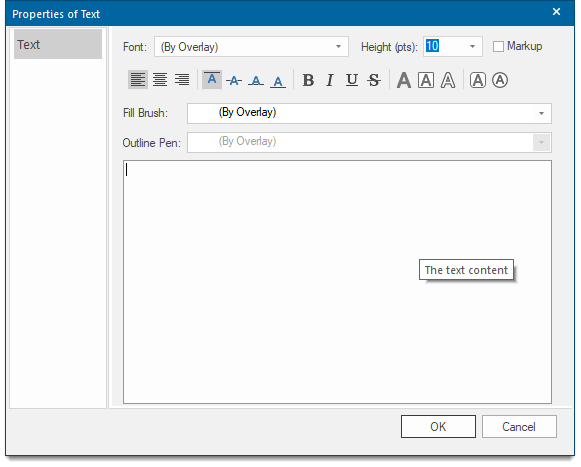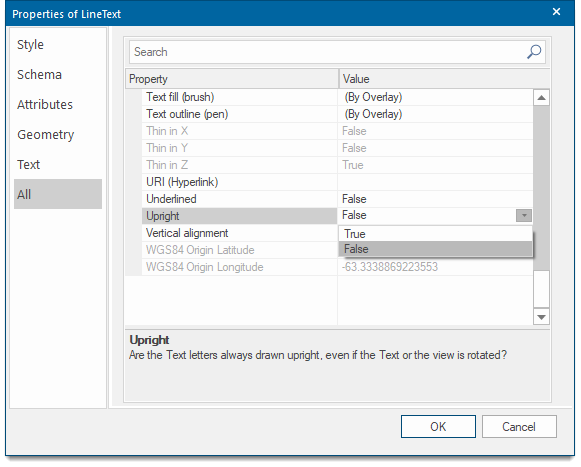Point
Point creates a Text item justified to a point.
- To insert text, select Create > Home > Point.

- This opens the Point text window.

- Now start typing in the field. You can enter one or more lines of text; just press Enter to start a new line.
- When you have finished, click OK.
- Now click a point on the screen where you want to locate the text. This point now becomes the current alignment point, and the Text item is justified both horizontally and vertically about this point.
- If needed, enter a second point to rotate the Text item. Else press Enter.
Font
Select the font to apply to the text from the drop-down box.
Height (pts)
Select the text height in points.Text height is set in point sizes, the same as text in word-processing. There are 72 points to the inch. One point is approximately 0.01389 inches, or 0.353 millimetres.
Markup
The Markup option allows a single text item to have multiple styles, e.g. Bold, Italic, etc., and/or multiple colours; and/or multiple fonts.
These states are:
|
*bold* |
*This is bold text* will display: This is bold text |
|
_italic_ |
_This is italic_ will display: This is italic |
|
^superscript^ |
*Area = 25^2^* will display: Area = 252 (bold and superscript) |
|
~subscript~ |
~This is subscript~ will display: This is subscript |
|
-strikeout- |
-This is strikeout- will display: |
Note: The font size cannot be changed using Markup.
Multiple text colours in a text item:
The code to set text colour is: %{fill:#RGB values} text to be coloured%
This is%{fill:#00AA00} green% and this is%{fill:#0000FF} blue% text
will be displayed as:
This is green and this is blue text
Multiple fonts in a text item:
The code to set a font is: %{font-family:FontName}
This font is %{font-family:Gothic} Gothic% whereas this font is *_%{font-family:Times}Times in bold italic%_*.
will be displayed as:
This font is Castellar whereas this font is Times in bold italic.
Defining Outline text:
The code to set Outline text is: %{fill:Fill Brush colour; outline:Outline Pen colour}required text%
%{fill:#FF0000; outline:#0000FF}red fill blue outline%
will be displayed as:

Escape characters
Characters can be "escaped" (i.e. have their markup meaning ignored) by prefixing with a \
*This text is bold* but \*this text isn't (it has an asterisk before and after it instead)\*
will be displayed as:
This text is bold but *this text isn't (it has an asterisk before and after it instead)*
Justification: Left, Centre or Right

Set the text justification as required.
Vertical alignment:Top, Middle, Baseline or Bottom

Set the text vertical alignment as required.
Bold, Italic, Underline, Strikethrough

Any combination of Bold, Italic, Underlined and Strikethrough can be selected.
Opaque, Box, Outline, Rounded rectangle

If creating Outline Text use any of these options.
Fill Brush
Select the required brush to set the text colour.
Implicit brushes may also be defined. The facility of copying and pasting the brush specification in JSON is also available.
Outline Pen
This field will become active if the Outline text A button is selected: Not available for simple text

Text window
Type in the required text (if required use the syntax as described in Markup if required, press Enter for a new line). You can also paste text into this box using the Ctrl+C/Ctrl+V key combination, or Paste on the local menu.
Click OK when you have finished entering text. The text item is attached to your cursor. If the display scale allows it, you will see a box indicating the size the text item will be.
Click the screen position where you want to place the alignment point of the text item.
Either:
- press Enter to place the text string horizontally.
- click a second point, which defines the angle of rotation of the text.
If your text item isn’t visible, it may be too small or too large for the current display scale. Selection [Home-Zoom] will display it. Try redrawing your screen (Redraw [Home-Map] or F5) for the text to appear.
Text size is determined by its "Point" height, and its dataset scale. The Point height is a size on paper and will be familiar to Word Processor users. Most graphics in a dataset correspond to the real world, and not to paper (e.g. roads).
Since Cadcorp SIS Desktop 9.1 must draw real-world graphics and Text into the same window, it needs to know the scale of the dataset. (If the scale is unsuitable, another dataset scale will be automatically suggested. This is most likely to happen when you are constructing Point text on an internal dataset, because these take an initial dataset scale of 1 when they are created.)
If you later change the dataset scale, then all the Text appears to change size.
To permanently fix the size of the text relative to real-world graphics, use Box (Box Text).
To edit Point text select the text and use the local Properties command, Text tab. See Editing Text.
Point text always appears at the same size (its point size).
If you change the dataset scale, the size of the point text will change. Dataset scale does not affect other text types, such as Box (Box Text), Label (Box Label) and Line (Line Text).
To give Point text a fixed screen height
Point text with a fixed screen height remains the same height (in pixels) on the screen, no matter how much you zoom in or out.
Fixed height text (or “zoom independent text”) is useful in such circumstances as labelling a KeyMap, or labelling symbols.
To make your Point text fixed height, use a negative value in the Height (pts) box. For example, a value of -10 would produce text at point height 10, irrespective of dataset scale.
Rendering Line Text characters upright individually
Line text characters can be rendered upright individually by setting the _text_upright& flag to True.
This allows you to rotate the text but keep the characters horizontal, giving a step effect.
To do this, open the text item's local menu (right-click on the item) and choose Properties > All. By default, the _text_upright& flag is set to False.
Examples showing the effect of Upright False and True settings:

